NCERT Solutions for Class 10 Maths Chapter 6 Triangles Ex 6.6 are part of NCERT Solutions for Class 10 Maths. Here are we have given Chapter 6 Triangles Class 10 NCERT Solutions Ex 6.6.
- Triangles Class 10 Ex 6.1
- Triangles Class 10 Ex 6.2
- Triangles Class 10 Ex 6.3
- Triangles Class 10 Ex 6.4
- Triangles Class 10 Ex 6.5
| Board | CBSE |
| Textbook | NCERT |
| Class | Class 10 |
| Subject | Maths |
| Chapter | Chapter 6 |
| Chapter Name | Triangles |
| Exercise | Ex 6.6 |
| Number of Questions Solved | 10 |
| Category | NCERT Solutions |
NCERT Solutions for Class 10 Maths Chapter 6 Triangles Ex 6.6
NCERT Solutions for Class 10 Maths
Question 1. In the given figure, PS is the bisector of ∠QPR of ∆PQR. Prove that
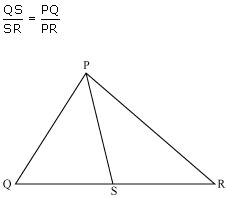
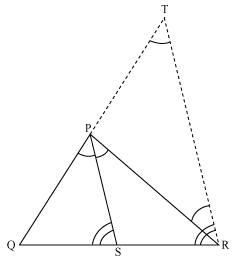
Let us draw a line segment RT parallel to SP which intersects extended line segment QP at point T.
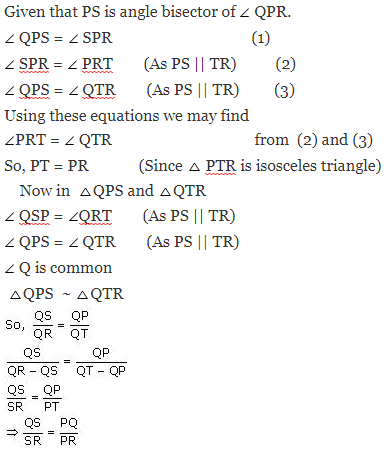
(i). DM2 = DN.MC
(ii). DN2 = DM.AN
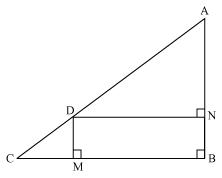
Solution:
(i). Let us join DB.
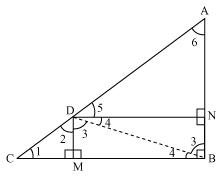
DN || CB
DM || AB
So, DN = MB
DM = NB
The condition to be proved is the case when DNBM is a square or D is the midpoint of side AC.
Then ∠CDB = ∠ADB = 90°
∠2 + ∠3 = 90° (1)
In ∆CDM
∠ 1 + ∠ 2 + ∠ DMC = 180°
∠ 1 + ∠ 2 = 90° (2)
In ∆DMB
∠ 3 + ∠ DMB + ∠ 4 = 180°
∠ 3 + ∠ 4 = 90° (3)
From equation (1) and (2)
∠ 1 = ∠ 3
From equation (1) and (3)
∠ 2 = ∠ 4
∆BDM ~ ∆ DCM

(ii). Similarly in ∆DBN
∠ 4 + ∠ 3 = 90° (4)
In ∆DAN
∠ 5 + ∠ 6 = 90° (5)
In ∆DAB
∠4 + ∠ 5 = 90° (6)
From equation (4) and (6)
∠3 = ∠ 5
From equation (5) and (6)
∠4 = ∠ 6
∆DNA ~ ∆BND

Question 3. In the given figure, ABC is a triangle in which ∠ ABC> 90° and AD ⊥ CB produced.
Prove that AC2 = AB2 + BC2 + 2BC . BD.
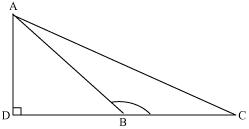
In ∆ADB applying Pythagoras theorem
AB2 = AD2 + DB2 (1)
In ∆ACD applying Pythagoras theorem
AC2 = AD2 + DC2
AC2 = AD2 + (DB + BC)2
AC2 = AD2 + DB2 + BC2 + 2DB x BC
Now using equation (1)
AC2 = AB2 + BC2 + 2BC . BD
Question 4. In the given figure, ABC is a triangle in which ∆ ABC < 90° and AD ⊥ BC. Prove that AC2 = AB2 + BC2 – 2BC.BD.
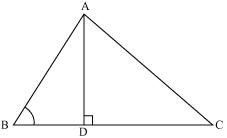
In ∆ADB applying Pythagoras theorem
AD2 + DB2 = AB2
AD2 = AB2 – DB2 (1)
In ∆ ADC applying Pythagoras theorem
AD2 + DC2 = AC2 (2)
Now using equation (1)
AB2 – BD2 + DC2 = AC2
AB2 – BD2 + (BC – BD)2 = AC2
AC2 = AB2 – BD2 + BC2 + BD2 – 2BC. BD
= AB2 + BC2 – 2BC. BD
Question 5. In the given figure, AD is a median of a triangle ABC and AM ⊥ BC. Prove that:

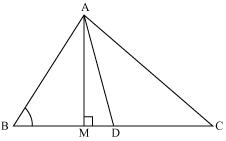
(i). In ∆AMD
AM2 + MD2 = AD2 (1)
In ∆AMC
AM2 + MC2 = AC2 (2)
AM2 + (MD + DC)2 = AC2
(AM2 + MD2) + DC2 + 2MD.DC = AC2
Using equation (1) we may get
AD2 + DC2 + 2MD.DC = AC2
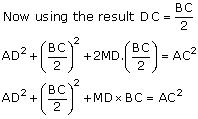
AB2 = AM2 + MB2
= (AD2 – DM2) + MB2
= (AD2 – DM2) + (BD – MD)2
= AD2 – DM2 + BD2 + MD2 – 2BD.MD
= AD2 + BD2 – 2BD.MD
 (iii). In ∆AMB
(iii). In ∆AMBAM2 + MB2 = AB2 (1)
In ∆ AMC
AM2 + MC2 = AC2 (2)
Adding equation (1) and (2)
2AM2 + MB2 + MC2 = AB2 + AC2
2AM2 + (BD – DM)2 + (MD + DC)2 = AB2 + AC2
2AM2+BD2 + DM2 – 2BD.DM + MD2 + DC2 + 2MD.DC = AB2 + AC2
2AM2 + 2MD2 + BD2 + DC2 + 2MD (-BD + DC) = AB2 + AC2

Question 6. Prove that the sum of the squares of the diagonals of parallelogram is equal to the sum of the squares of its sides.
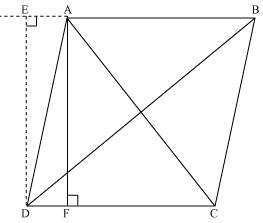
Let ABCD be a parallelogram
Let us draw perpendicular DE on extended side AB and AF on side DC.
In ∆DEA
DE2 + EA2 = DA2 (i)
In ∆DEB
DE2 + EB2 = DB2
DE2 + (EA + AB)2 = DB2
(DE2 + EA2) + AB2 + 2EA. AB = DB2
DA2 + AB2 + 2EA.AB = DB2 (ii)
In ∆ADF
AD2 = AF2 + FD2
In ∆ AFC
AC2 = AF2 + FC2
= AF2 + (DC – FD)2
= AF2 + DC2 + FD2 – 2DC – FD
= (AF2 + FD2) + DC2 – 2DC . FD
AC2 = AD2 + DC2 – 2DC FD (iii)
Since ABCD is a parallelogram
AB = CD (iii)
And BC = AD (iv)
In ∆DEA and ∆ADF
∠ DEA = ∠ AFD
∠ EAD = ∠ FDA (EA || DF)
∠ EDA = ∠ FAD (AF || ED)
AD is common in both triangles.
Since respective angles are same and respective sides are same
∆DEA ≅ ∆AFD
So EA = DF (v)
Adding equation (ii) and (iii)
DA2 + AB2 + 2EA.AB + AD2 + DC2 – 2DC.FD = DB2 + AC2
DA2 + AB2 + AD2 + DC2 + 2EA.AB – 2DC.FD = DB2 + AC2
BC2 + AB2 + AD2 + DC2 + 2EA.AB-2AB.EA = DB2 + AC2
AB2 + BC2 + CD2 + DA2 = AC2 + BD2
Question 7. In the given figure, two chords AB and CD intersect each other at the point P.
prove that: (i) ∆APC ~ ∆DPB (ii) AP.PB = CP.DP
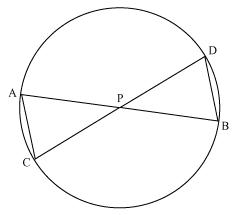
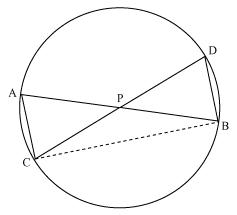
Let us join CB
(i) In ∆APC and ∆DPB
∠APC = ∠DPB {Vertically opposite angles}
∠CAP = ∠BDP {Angles in same segment for chord CB}
∆APC ~ ∆DPB {BY AA similarly criterion}
(ii) We know that corresponding sides of similar triangles are proportional

(i) ∆PAC ~ ∆PDB (ii) PA.PB = PC.PD
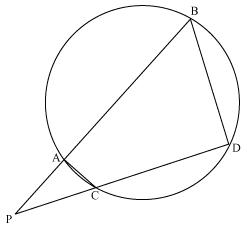
Solution:
(i) In ∆PAC and ∆PDB
∠ P = ∠ P (common)
∠ PAC = ∠ PDB (exterior angle of a cyclic quadrilateral is equal to opposite interior angle)
∠ PCA = ∠PBD
∆PAC ~ ∆PDB
(ii) We know that corresponding sides of similar triangles are proportional.

Question 9. In the given figure, D is a point on side BC of ∆ ABC such that \(\frac { BD }{ CD } =\frac { AB }{ AC }\) Prove that AD is the bisector of ∠ BAC.
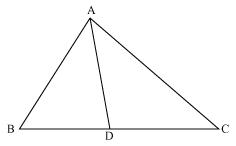
In ∆ DBA and ∆DCA
\(\frac { BD }{ CD } =\frac { AB }{ AC }\) (given)
AD = AD (common)
So, ∆DBA ~ ∆DCA (By SSS)
Now, corresponding angles of similar triangles will be equal.
∠ BAD = ∠ CAD
AD is angle bisector of ∠ BAC.
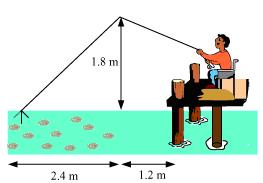
Solution:
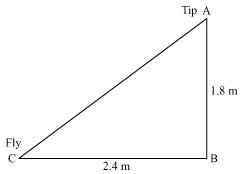
Let AB be the height of tip of fishing rod from water surface. Let BC be the horizontal distance of fly from the tip of fishing rod.
Then, AC is the length of string.
AC can be found by applying Pythagoras theorem in ∆ABC
AC2 = AB2 + BC2
AC2 = (1.8)2 + (2.4)2
AC2 = 3.24 + 5.76
AC2 = 9.00
AC = √9 = 3
Thus, length of string out is 3 m.
Now, she pulls string at rate of 5 cm per second.
So, string pulled in 12 seconds = 12 x 5 = 60 cm = 0.6 m

Let after 12 second Fly be at point D.
Length of string out after 12 second is AD
AD = AC – string pulled by Nazima in 12 seconds
= 3.00 – 0.6
= 2.4
In ∆ ADB
AB2 + BD2 = AD2
(1.8)2 + BD2 = (2.4)2
BD2 = 5.76 – 3.24 = 2.52
BD = 1.587
Horizontal distance of fly = BD + 1.2
= 1.587 + 1.2
= 2.787
= 2.79 m.
We hope the NCERT Solutions for Class 10 Maths Chapter 6 Triangles Ex 6.6 help you. If you have any query regarding NCERT Solutions for Class 10 Maths Chapter 6 Triangles Ex 6.6, drop a comment below and we will get back to you at the earliest.